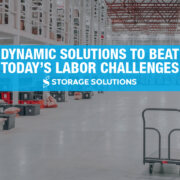Throughout the supply chain, businesses are experiencing labor challenges in various ways, and it has taken a toll on throughput and profitability for many.
First of all, labor availability is at an all-time low, and fulfillment centers are routinely operating at below capacity because of it. That puts undue pressure on the remaining workers, who are then overextended in attempting to meet consumers’ increasing expectations on quicker delivery for an ever-increasing share of e-commerce orders. In this environment, fulfillment centers are also adjusting to fewer shipments of full pallets and a more significant share of each or order picks, which are more expensive and lead to increased labor costs.
Plus, because labor availability is so low, companies are required to raise wages – and sometimes add bonuses – to attract new employees. That factor makes employee retention more difficult because now there is more competition for those higher-paying jobs, so workers are more apt to jump from one company to another. So, in changing careers and changing companies, quality control is affected as more employees need to be trained.
In short, the labor market is a mess right now. COVID-19 and other external factors have caused a dramatic shift in supply chain employment, and companies are feeling the pain of all these changes. Some have adopted dynamic strategies to reduce dependency on human labor for fulfilling orders, and some are in the process of investigating potential options for their operations.
In fact, one of the most common themes we hear from clients is that they may have waited too late, and now they need to play catch-up. We have found that clients are getting their biggest “bang for the buck” on integrating solutions around their picking, packing, and replenishment operations.
Below are a few dynamic solutions we design and provide that may help your business catch up to meet today’s challenges, but in reality, these solutions should also come with a roadmap to help your operations adapt to future challenges that may be unforeseen.
Adding Conveyor and Sortation Solutions
Conveyor and sortation solutions can be a solvent for labor challenges, primarily by reducing the amount of physical travel required by transporting products long distances within a facility. Through proper design, conveyors can dramatically improve fulfillment speeds, add quality control, and improve safety in a facility.
Even if you have a conveyor system currently running in your facility, it may be time to re-evaluate your design as demand and needs change. Retrofitting existing conveyors with new parts, sortation solutions, or new motors can also make a sizeable impact on your replenishment, picking, and packing efforts.
Condense Your Footprint with Vertical Lift Modules
While condensing your storage doesn’t always directly solve labor challenges, vertical lift modules (VLMs) offer various benefits to fulfillment operations, particularly when it comes to picking items to a cart. VLMs offer a fully-automated goods-to-person picking and storage solution that can be ideal when your process involves small-to-medium products.
Pick-to-light batching tables can be incorporated to allow for picking multiple orders to drive higher pick rates and eliminate guesswork from the batching process. With these high pick rates and additional throughput and accuracy, you can drive labor savings.
Introduce Automated Warehouse Robotics
Autonomous mobile robots (AMRs) and autonomous guided vehicles (AGVs) are two typical warehouse solutions to labor challenges because of their fulfillment rates, operational costs, safety benefits, and order accuracy. Our partners at Fetch Robotics and inVia Robotics work with your labor force to support replenishment, picking, and transportation of products. These solutions can be installed as a subscription service, meaning you don’t have to invest in massive infrastructure at your facility.
These solutions integrate with your warehouse management systems (WMS) to optimize pick paths to support your pick process or do the picking entirely, depending on your needs. Ultimately, though, they remove the costliest aspect of fulfillment – humans walking through a warehouse.
Reduce Costs When You Automate Your Packaging
Especially as a greater share of orders are being shipped individually than by-the-pallet, automating your packaging process can support increased throughput and lower labor costs. From case sealers to auto-baggers to print-and-apply labeling systems, there are several solutions that can prevent you from paying someone to package individual or group orders.
These end-of-the-line solutions can automatically measure and add void-fill, reducing waste, freight costs, and can improve customer satisfaction along the way.
Invest in Automation with Goods-to-Person Picking Systems
Even if you have no level of automation in your operations, it may be worth investigating how to integrate automated goods-to-person picking systems in your facility. However, before diving in too deep, we recommend speaking with an expert that has conducted a data-driven analysis of your material flow to determine the right solution for your business goals.
Automated storage and retrieval systems (AS/RS) can come in cart-based solutions, crane-based solutions, cart-crane combinations, mini-load AS/RS, and more. They all drive extremely high pick rates, optimal storage design, ergonomic support and can scale as your business goals grow. However, because there are so many options out there, finding the right solution requires the design and expertise of a proper project partner. We’d be happy to discuss these options with you!
Need Some Advice? Contact an Expert
Our team of experts has experience with various solutions that can relieve the dependency on labor and drive an ROI by increasing your throughput. For us, solving labor challenges is less about eliminating workers but more about keeping your best employees around by making their jobs more accessible, more consistent and creating opportunities for less wear-and-tear per pick.


